Cold weather pet safety tips
by Ontario SPCA and Humane Society | General Pet Care | November 30, 2023

With the winter season upon us, it is important to remember that our furry friends can also get cold. If it’s too cold for you, then it’s too cold for your companion animal!
When the temperature drops below freezing, animals should not be left outside for extended periods. Cats, short-coated dogs and puppies are particularly vulnerable in cold temperatures. Senior animals, underweight animals or those battling underlying medical conditions can also be very vulnerable.
Keep cats indoors and protect your dogs from frostbite or hypothermia (cold stress) by taking them outside for short periods during cold weather. Some dogs, especially puppies and short-coated breeds, may benefit from a dog sweater or coat as an extra layer of warmth.
Remember to always check for signs that your companion animal may be cold or uncomfortable during the winter.
Signs that your dog is cold
- Shaking or shivering
- Hunched posture with a tucked tail
- Whining or barking
- Change in behaviour, showing anxiety
- Reluctance to keep walking or tries to turn around
- Seeks places to shelter
- Lifts paw off the ground
Signs of hypothermia
Wrap your furry friend in a blanket or coat, seek a warm shelter and immediate veterinary support for your furry family member if you see any of the following:
- Frostbite (can take several days to develop)
– Often presents on the extremities (ears, legs, paws, tail)
– Pale, cold skin that can be painful to touch
– May develop redness, swelling and blisters of exposed skin
– Skin may turn black - Hypothermia (can range from mild to severe)
– Prolonged shivering
– Weakness
– Muscle stiffness
– Difficulty walking
– Pale gums
– Confusion
– Slow, shallow breathing
– Loss of consciousness
Though it’s important to pay attention to these things, you shouldn’t wait to see the first signs of discomfort to call your walk or playtime quits. While maintaining your dog’s exercise requirements during the winter is important, when conditions are especially cold it’s a good idea to cut your walk short and supplement your animal’s exercise with some indoor activities and enrichment.
Other tips to keep in mind:
- When the temperature drops below freezing, your furry friends should not be left outside for extended periods.
- Cats, short-coated dogs and puppies are more vulnerable in cold temperatures.
- Keep cats indoors and protect your dogs from frostbite or hypothermia by taking them outside for only short periods.
- If needed, consider dog sweaters or coats as an extra layer of warmth for especially cold days.
- Never shave your dog down in the winter; a longer coat will provide more warmth. (With an exception to shave matted fur, as matted fur can make furry friends very susceptible to the cold.)
- When bathing your dog during winter months, be sure they are completely dry before taking them outside.
More precautions:
- Use a damp towel to wipe your dog’s paws and underside after being outside.
- Salt and other chemicals used to melt snow and ice on roads and sidewalks can irritate and burn your furry friend’s paws – and cause illness if ingested.
- Consider using “booties” to protect paws.
- Keep your dog on a leash, especially during a snowstorm, since dogs can have difficulty following a scent in fresh snow and can easily become lost. They may also not be as visible to oncoming traffic in snowstorms, so staying on a leash and having high visibility/reflective material on would be very helpful as well.
- Ensure your furry friend has a warm place to sleep away from drafts and off the floor – a thick cozy dog or cat bed with a blanket or pillow is great!
Visit our blog for more winter animal care tips.
Categories
Testimonial
Hats off to you
To all kind-hearted and hard-working people at SPCA: hats off to you. I love animals and admire the work you do.
